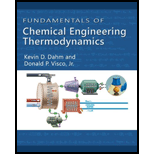
(A)
Interpretation:
The rate at which work is produced
Concept Introduction:
Write the entropy balance equation around a reversible turbine.
Here, final molar entropy is
Write the expression for difference in entropy in terms of residual properties.
Here, final residual molar entropy is
Write the molar entropy residual function.
Here, gas constant is
Write the expression to calculate the reduced temperature.
Here, critical temperature is
Calculate the reduced pressure
Here, pressure is P.
Write the expression to calculate the compressibility factor
Here, compressibility of compound with
Write the equation to calculate the ideal gas change in entropy.
Here, constant volume heat capacity for ideal gas is
Write the formula to calculate the constant volume heat capacity for ideal gas
Here, ideal gas coefficients are
Write the energy balance for the turbine.
Here, mass flow rate is
Write the difference in entropy in terms of residual properties.
Here, molar enthalpy for an ideal gas state at state 2 and 1 is
Write the residual molar enthalpy for the entering toluene:
Here, initial residual molar enthalpy is
(B)
Interpretation:
The rate at which work is produced
Concept Introduction:
Write the relationship between the parameter, m and Soave’s EOS.
Here, the acentric factor is
Write the expression to calculate the
Here, reduced temperature is
Write the expression to calculate the reduced temperature.
Here, critical temperature is
Write the expression to calculate the value of a at the critical point.
Write the expression to calculate the value of b using the Soave equation.
Write the Peng-Robinson equation.
Here, molar volume is
Write the dimensionless group parameter that includes the Peng-Robinson parameter.
Here, dimensionless group parameter is
Write the dimensionless group parameter that includes the Peng-Robinson parameter.
Here, dimensionless group parameter is
Write the residual molar enthalpy for the inlet.
Write the difference in entropy in terms of residual properties.
Here, molar enthalpy for an ideal gas state at state 2 and 1 is
Trending nowThis is a popular solution!

Chapter 7 Solutions
Fundamentals of Chemical Engineering Thermodynamics (MindTap Course List)
 Introduction to Chemical Engineering Thermodynami...Chemical EngineeringISBN:9781259696527Author:J.M. Smith Termodinamica en ingenieria quimica, Hendrick C Van Ness, Michael Abbott, Mark SwihartPublisher:McGraw-Hill Education
Introduction to Chemical Engineering Thermodynami...Chemical EngineeringISBN:9781259696527Author:J.M. Smith Termodinamica en ingenieria quimica, Hendrick C Van Ness, Michael Abbott, Mark SwihartPublisher:McGraw-Hill Education Elementary Principles of Chemical Processes, Bind...Chemical EngineeringISBN:9781118431221Author:Richard M. Felder, Ronald W. Rousseau, Lisa G. BullardPublisher:WILEY
Elementary Principles of Chemical Processes, Bind...Chemical EngineeringISBN:9781118431221Author:Richard M. Felder, Ronald W. Rousseau, Lisa G. BullardPublisher:WILEY Elements of Chemical Reaction Engineering (5th Ed...Chemical EngineeringISBN:9780133887518Author:H. Scott FoglerPublisher:Prentice Hall
Elements of Chemical Reaction Engineering (5th Ed...Chemical EngineeringISBN:9780133887518Author:H. Scott FoglerPublisher:Prentice Hall
 Industrial Plastics: Theory and ApplicationsChemical EngineeringISBN:9781285061238Author:Lokensgard, ErikPublisher:Delmar Cengage Learning
Industrial Plastics: Theory and ApplicationsChemical EngineeringISBN:9781285061238Author:Lokensgard, ErikPublisher:Delmar Cengage Learning Unit Operations of Chemical EngineeringChemical EngineeringISBN:9780072848236Author:Warren McCabe, Julian C. Smith, Peter HarriottPublisher:McGraw-Hill Companies, The
Unit Operations of Chemical EngineeringChemical EngineeringISBN:9780072848236Author:Warren McCabe, Julian C. Smith, Peter HarriottPublisher:McGraw-Hill Companies, The





